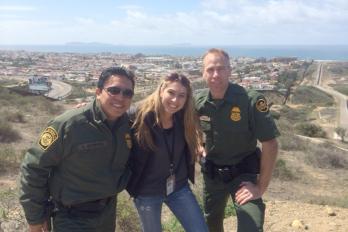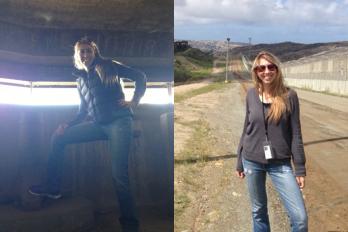Unique Insider’s Perspective – Otay Mesa Port of Entry Border Crossing
April 24, 2014
By Stephanie Ferguson, 3L
Intellectual Property Fellow
The Otay Mesa Port of Entry is one of two border crossings within the city of San Diego, the other being the San Ysidro Port of Entry six miles to the west. As a judicial extern for the United States District Court, I had the opportunity to take a private tour of the Otay Mesa Port of Entry and border with United States Customs and Border Patrol officers on Thursday, March 27, 2014. The officers explained that these tours are only available to those affiliated with the District Court, members of Congress, the U.S. Attorney’s Office, and U.S. Presidents. Their tour was incredibly informative, and offered an intimate look at how they keep our borders secure and enforce our nation’s laws every day.
During the first half of the tour, U.S. Customs officials walked us out to “The Line” to observe the automobile checkpoint, showing us the primary and secondary methods used to search vehicles. The Otay Mesa Border Crossing is the sixth busiest border in the United States and processes on average 9,000 pedestrians and 20,000 cars every day.
Once we finished at “The Line,” for the second half of the tour we piled into a Border Patrol van and traveled eight miles running along the border between the San Ysidro Port of Entry through the Tijuana Port of Entry, and all the way to the Pacific Ocean. Our vehicle took us off-road, traveling down the border between the primary and secondary security fences, a narrow, heavily patrolled area that is off-limits to civilians. Some of the highlights of the drive included driving through “Smuggler’s Gulch,” an area that got its name decades ago, as every type of contraband imaginable from cattle to moonshine, and cocaine to human trafficking once flowed through. Our Border Patrol agent guides were extremely enthusiastic, friendly, and insightful, pointing out the locations of various drug tunnels and “hot spots” for trafficking.
Border Bunkers
Perched up on a hill overlooking the Pacific Ocean, the old World War II bunkers were a historical highlight of our tour. Nicknamed the “border bunkers” on Bunker Hill, they are built into the ocean-facing hillside just a few yards from the metal fence marking the U.S.-Mexico border. Installed in 1942, these three bunkers are the southernmost of a series of military installations along the San Diego coastline built to scan the horizon for invading Japanese ships and submarines. The enemy troops never arrived, and Bunker Hill was abandoned once the war was over. The Federal Government has since taken control of the property and the U.S. Border Patrol monitors it daily.
When the Border Patrol agents gave us permission to explore the bunkers at our own risk, I was the first one adventurous enough to climb down the ladder into a bunker, only to be greeted by one surviving lizard and several shed snake skins. What I thought would be a dank and eerie space surprised me. It was very calming and quiet, and a cool breeze swept through the bunker as I looked out at panoramic views of the Pacific Ocean with the horizon in the distance.
Opportunities for Law Students in District Courts
As an Intellectual Property Fellow focusing on anti-counterfeit enforcement, this private tour offered me an up close and personal perspective of how our borders are protected. If not for my judicial externship with the District Court, I would not have had this unique opportunity. Judicial externs and clerks in the United States federal court system can take advantage of excellent educational opportunities, including court room exposure from both sides of the bench, honing legal writing and research skills, and tours of the Federal Pre-trial facilities. The Port of Entry and Border tour was only one of many memorable experiences provided through my externship. I encourage all law students to consider clerking or externing for the District Courts.
Ms. Ferguson is currently a judicial extern to the Honorable Roger T. Benitez ’78 at the United States District Court, Southern District of California.

